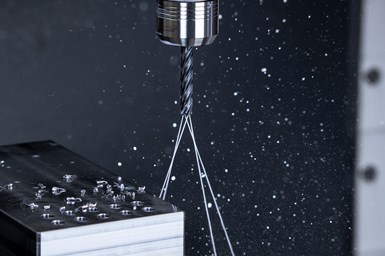Ceratizit Releases WTX, World's First Four-Fluted Drill
CERATIZIT has released its WTX High-Feed Drill, which it says is the first four-fluted drill available on the market. Its design should result in longer tool life and increased drilling quality.
Share






CERATIZIT USA Inc. has released the WTX High-Feed Drill, which the company says is the first four-fluted drill on the market. CERATIZIT also says the drill’s four effective cutting edges increase precision, productivity and service life.
The pyramid geometry of the WTX encourages aggressive and precise drilling performance, with the company reporting the drill achieves positioning accuracy of 0.03 mm and excellent centering properties. CERATIZIT also says high levels of drilling quality, hole tolerance, surface finish and positioning accuracy increase component quality, to the extent that there is no need for potential reworking. Additionally, low burr formation when entering and exiting the hole reduces the need for time-consuming subsequent deburring.
The four-flute design of the WTX enables high feeds in steel processing, as well as secure and quick chip removal. The distribution of cutting force to four cutting edges should result in longer service life, while the four continuous spiral-through coolant holes provide enhanced cooling of each cutting edge to also prolong tool life and reduce costs.
CERATIZIT says its Dragonskin DPX14S coating on the WTX protects the drill and further increases tool life, cutting speeds and process reliability. Dragonskin utilizes TiAIN nanolayer coating with a .35 coefficient of friction and allows for maximum application temperatures of 1832ºF.
Related Content
-
Darex Adds End Mill Attachment to Drill Sharpener
This LEX600 end mill attachment enables users to sharpen the primary and secondary grind on the tips of two-, three- or four-fluted end mills up to 5/8".
-
Tungaloy Drills, Milling Inserts Provide Enhanced Stability
Tungaloy has expanded its DrillForceMeister and TecMill lines with new drill bodies and milling inserts.
-
Heule Cutting Tool Provides Chatter-Free Countersinks
PMTS 2025: GH-K tooling is well suited for conventional milling of chamfers around the perimeter of larger holes or entire parts.













